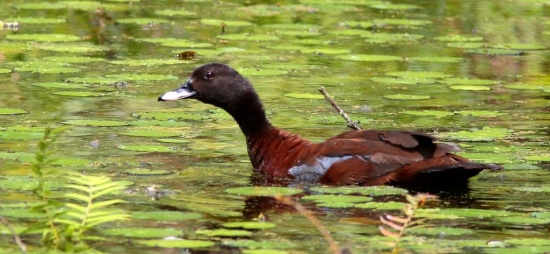(All sections now started. References updated. Incomplete gone) |
|||
| (12 intermediate revisions by 8 users not shown) | |||
| Line 1: | Line 1: | ||
| + | [[Image:Gggn.jpg|thumb|550px|right|Photo by {{user|Kwame+Brown|Kwame Brown}}<br />Ankasa National park, [[Ghana]], February 2017]] | ||
| − | ;Pteronetta | + | ;[[:Category:Pteronetta|Pteronetta]] hartlaubii |
| − | |||
| − | |||
| − | |||
| − | |||
| − | |||
| − | |||
| + | ==Identification== | ||
| + | 56–58 cm (22-22¾ in)<br /> | ||
| + | Dark chestnut overall with a black head and variable white markings to the head (often limited to a small white spot on the forehead near the bill-base). | ||
| + | ==Distribution== | ||
| + | Locally in forest streams of equatorial western [[Africa]]: found in [[Guinea]], [[Sierra Leone]], [[Liberia]], [[Ivory Coast]], [[Ghana]], [[Togo]], [[Nigeria]], [[Niger]], [[Cameroon]], [[Central African Republic]], [[Equatorial Guinea]], [[Gabon]], [[Democratic Republic of Congo]], [[Angola]], [[Sudan]], [[South Sudan]] and [[Uganda]] | ||
| + | ==Taxonomy== | ||
| + | This is a [[Dictionary_M-S#M|monotypic]] species<sup>[[#References|[1]]]</sup>. | ||
| + | ==Habitat== | ||
| + | Remote ponds and marshes in dense tropical evergreen forests and rivers and streams. | ||
| + | ==Behaviour== | ||
| + | Their diet consists mostly of aquatic invertebrates with the addition of roots and seeds. | ||
| + | ==Gallery== | ||
| + | Click on photo for larger image | ||
| + | <gallery> | ||
| + | Image:Hartlaubduck.jpg|Photo by {{user|MikeB.|MikeB.}}<br />[[Angola]], October 2007<!--EDITORS: this picture does not appear in the Gallery so retained here--> | ||
| + | </gallery> | ||
| + | ==References== | ||
| + | #{{Ref-Clements6thAug16}}#Avibase | ||
| + | #Handbook of the Birds of the World Alive (retrieved June 2017) | ||
| + | {{ref}} | ||
==External Links== | ==External Links== | ||
| − | + | {{GSearch|Pteronetta+hartlaubii}} | |
| − | [[Category:Birds]] [[Category: | + | [[Category:Birds]] [[Category:Pteronetta]] |
Latest revision as of 00:33, 4 June 2017
- Pteronetta hartlaubii
Identification
56–58 cm (22-22¾ in)
Dark chestnut overall with a black head and variable white markings to the head (often limited to a small white spot on the forehead near the bill-base).
Distribution
Locally in forest streams of equatorial western Africa: found in Guinea, Sierra Leone, Liberia, Ivory Coast, Ghana, Togo, Nigeria, Niger, Cameroon, Central African Republic, Equatorial Guinea, Gabon, Democratic Republic of Congo, Angola, Sudan, South Sudan and Uganda
Taxonomy
This is a monotypic species[1].
Habitat
Remote ponds and marshes in dense tropical evergreen forests and rivers and streams.
Behaviour
Their diet consists mostly of aquatic invertebrates with the addition of roots and seeds.
Gallery
Click on photo for larger image
References
- Clements, J. F., T. S. Schulenberg, M. J. Iliff, D. Roberson, T. A. Fredericks, B. L. Sullivan, and C. L. Wood. 2016. The eBird/Clements checklist of birds of the world: v2016, with updates to August 2016. Downloaded from http://www.birds.cornell.edu/clementschecklist/download/
- Avibase
- Handbook of the Birds of the World Alive (retrieved June 2017)
Recommended Citation
- BirdForum Opus contributors. (2024) Hartlaub's Duck. In: BirdForum, the forum for wild birds and birding. Retrieved 10 May 2024 from https://www.birdforum.net/opus/Hartlaub%27s_Duck





